A Critique of an Article on Oncology Nurse Safety in Chemotherapy
VerifiedAdded on 2023/06/03
|9
|2166
|270
Report
AI Summary
This report presents a critical review of an article examining the adherence of oncology nurses to safety guidelines when administering chemotherapy. The study, conducted at the Cleveland Clinic, assessed nurses' compliance with OSHA, NIOSH, and PPE recommendations. The research employed a mixed-methods design, using questionnaires and checklists to evaluate adherence. The findings revealed gaps in adherence to safety protocols, particularly in wearing gloves and institutional gowns. The report highlights the study's strengths, such as its ethical considerations and use of multiple assessment tools, while also pointing out limitations, including the small sample size and single-institution focus. The author recommends increasing sample sizes and incorporating comparative frameworks in future studies to improve the generalizability of the findings. The critique emphasizes the importance of adhering to established guidelines to ensure oncology nurses' operational safety and prevent occupational hazards.
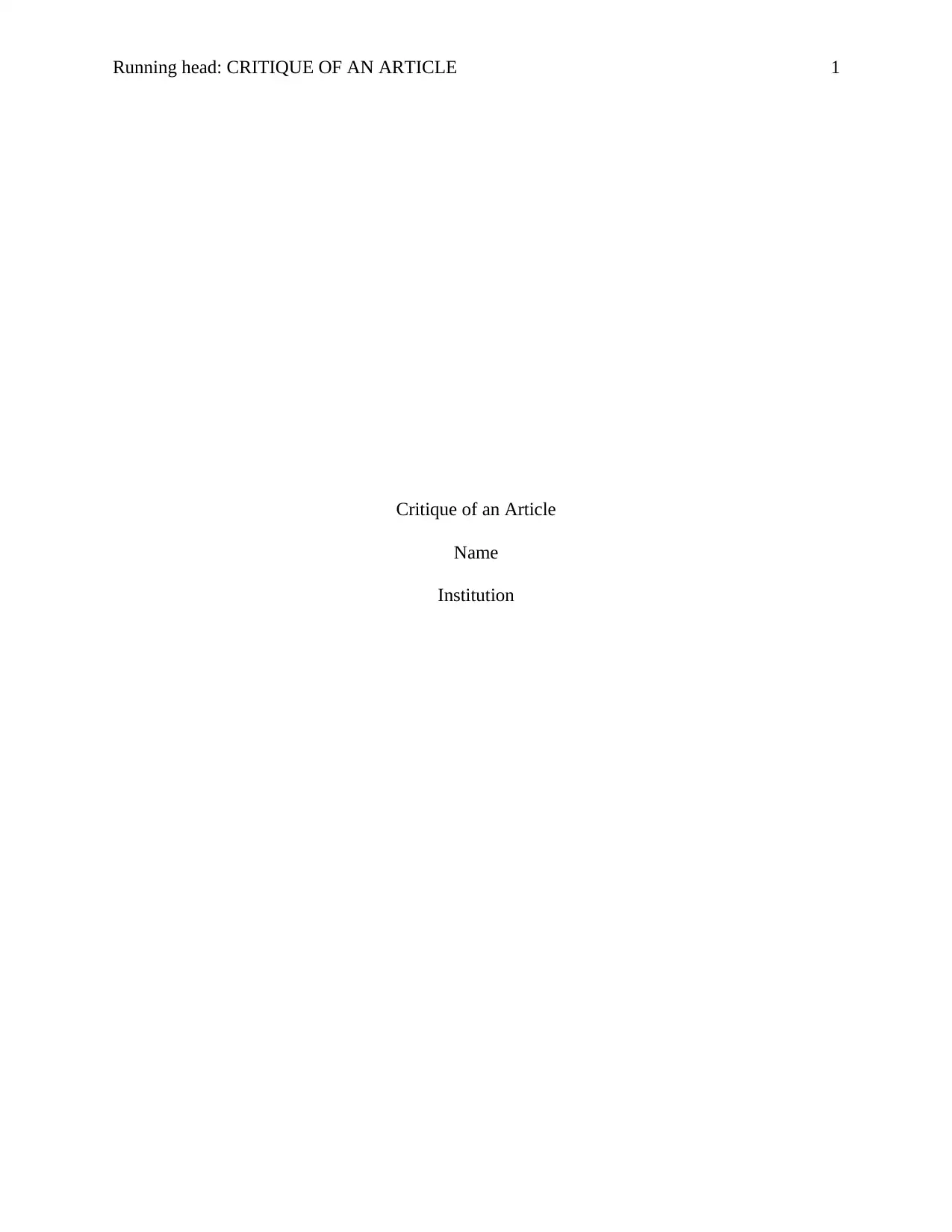
Running head: CRITIQUE OF AN ARTICLE 1
Critique of an Article
Name
Institution
Critique of an Article
Name
Institution
Paraphrase This Document
Need a fresh take? Get an instant paraphrase of this document with our AI Paraphraser
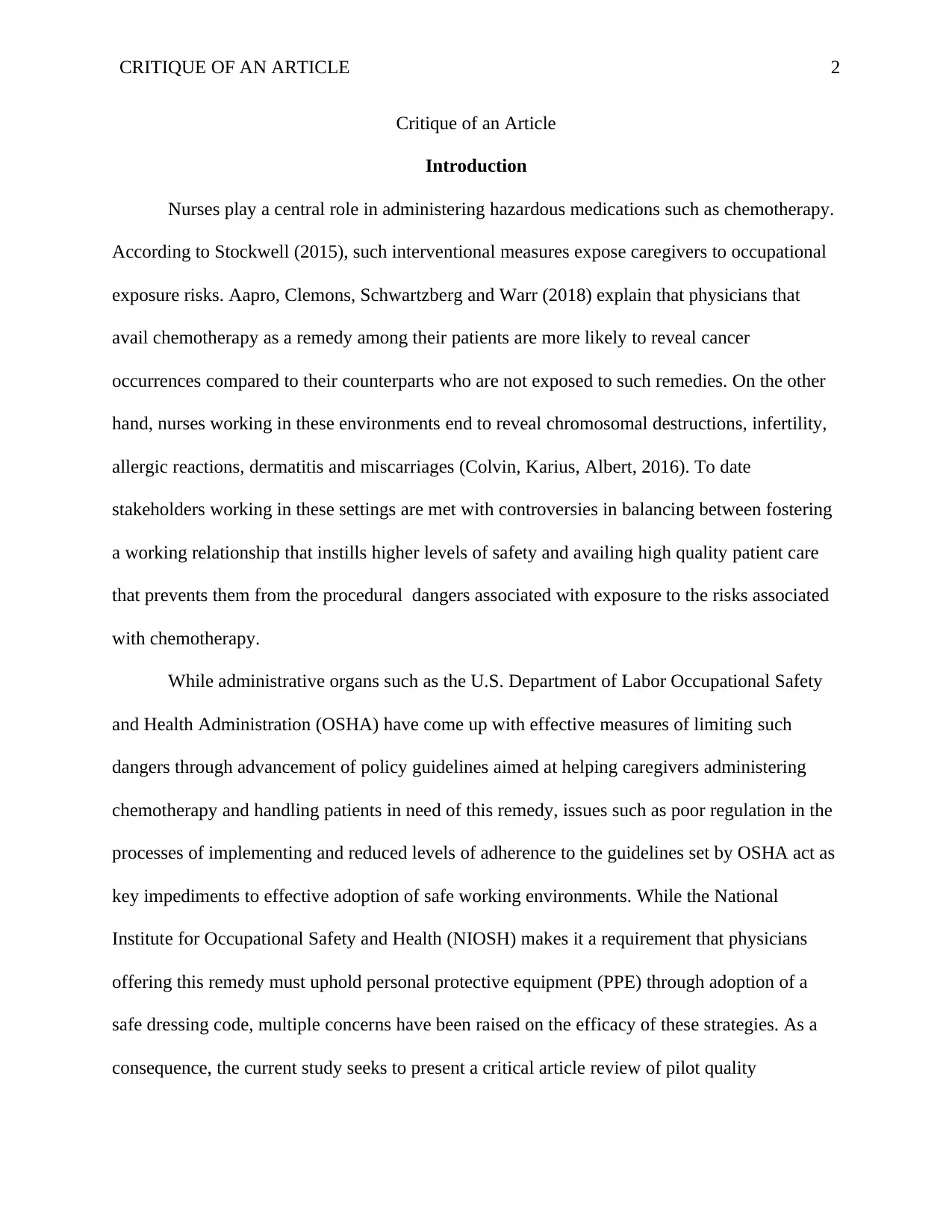
CRITIQUE OF AN ARTICLE 2
Critique of an Article
Introduction
Nurses play a central role in administering hazardous medications such as chemotherapy.
According to Stockwell (2015), such interventional measures expose caregivers to occupational
exposure risks. Aapro, Clemons, Schwartzberg and Warr (2018) explain that physicians that
avail chemotherapy as a remedy among their patients are more likely to reveal cancer
occurrences compared to their counterparts who are not exposed to such remedies. On the other
hand, nurses working in these environments end to reveal chromosomal destructions, infertility,
allergic reactions, dermatitis and miscarriages (Colvin, Karius, Albert, 2016). To date
stakeholders working in these settings are met with controversies in balancing between fostering
a working relationship that instills higher levels of safety and availing high quality patient care
that prevents them from the procedural dangers associated with exposure to the risks associated
with chemotherapy.
While administrative organs such as the U.S. Department of Labor Occupational Safety
and Health Administration (OSHA) have come up with effective measures of limiting such
dangers through advancement of policy guidelines aimed at helping caregivers administering
chemotherapy and handling patients in need of this remedy, issues such as poor regulation in the
processes of implementing and reduced levels of adherence to the guidelines set by OSHA act as
key impediments to effective adoption of safe working environments. While the National
Institute for Occupational Safety and Health (NIOSH) makes it a requirement that physicians
offering this remedy must uphold personal protective equipment (PPE) through adoption of a
safe dressing code, multiple concerns have been raised on the efficacy of these strategies. As a
consequence, the current study seeks to present a critical article review of pilot quality
Critique of an Article
Introduction
Nurses play a central role in administering hazardous medications such as chemotherapy.
According to Stockwell (2015), such interventional measures expose caregivers to occupational
exposure risks. Aapro, Clemons, Schwartzberg and Warr (2018) explain that physicians that
avail chemotherapy as a remedy among their patients are more likely to reveal cancer
occurrences compared to their counterparts who are not exposed to such remedies. On the other
hand, nurses working in these environments end to reveal chromosomal destructions, infertility,
allergic reactions, dermatitis and miscarriages (Colvin, Karius, Albert, 2016). To date
stakeholders working in these settings are met with controversies in balancing between fostering
a working relationship that instills higher levels of safety and availing high quality patient care
that prevents them from the procedural dangers associated with exposure to the risks associated
with chemotherapy.
While administrative organs such as the U.S. Department of Labor Occupational Safety
and Health Administration (OSHA) have come up with effective measures of limiting such
dangers through advancement of policy guidelines aimed at helping caregivers administering
chemotherapy and handling patients in need of this remedy, issues such as poor regulation in the
processes of implementing and reduced levels of adherence to the guidelines set by OSHA act as
key impediments to effective adoption of safe working environments. While the National
Institute for Occupational Safety and Health (NIOSH) makes it a requirement that physicians
offering this remedy must uphold personal protective equipment (PPE) through adoption of a
safe dressing code, multiple concerns have been raised on the efficacy of these strategies. As a
consequence, the current study seeks to present a critical article review of pilot quality
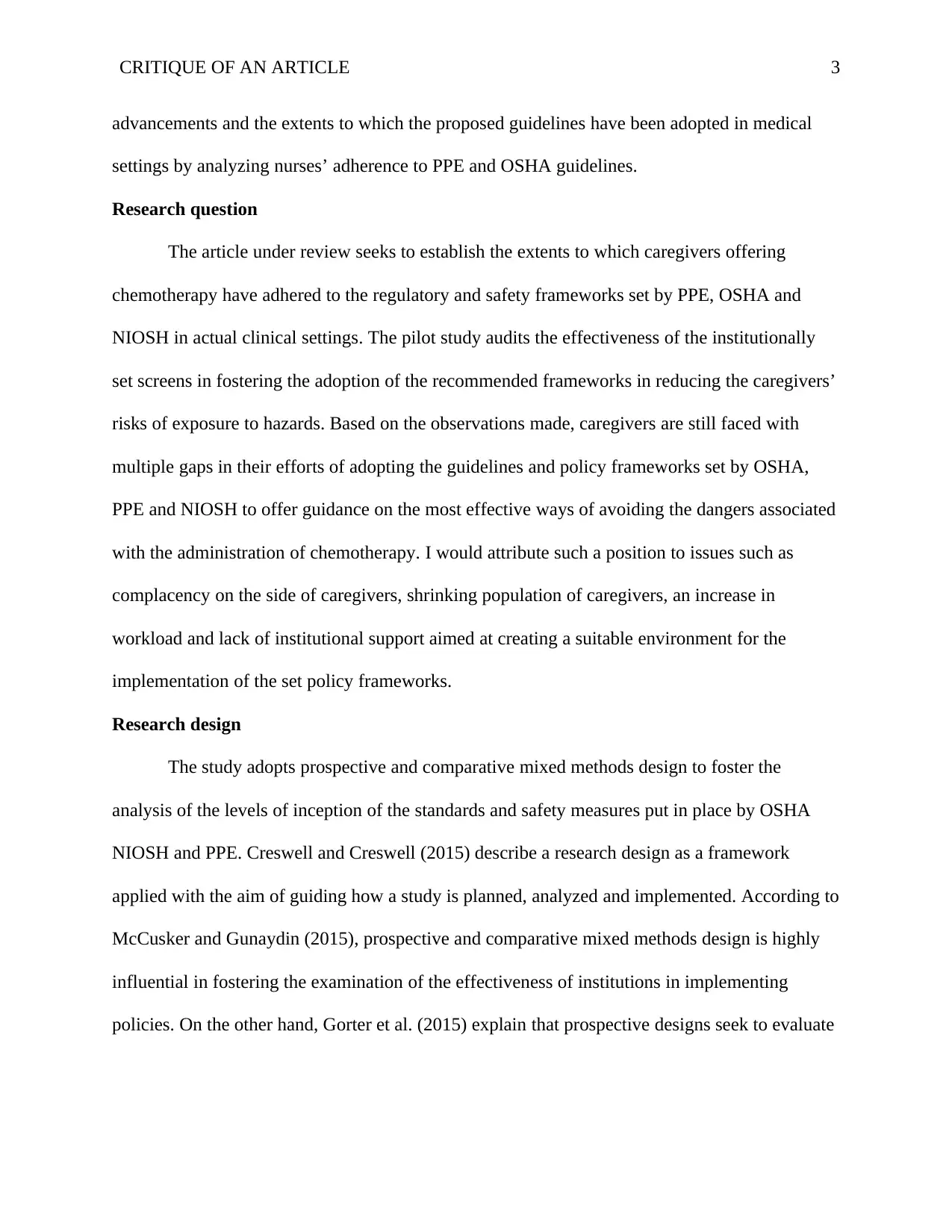
CRITIQUE OF AN ARTICLE 3
advancements and the extents to which the proposed guidelines have been adopted in medical
settings by analyzing nurses’ adherence to PPE and OSHA guidelines.
Research question
The article under review seeks to establish the extents to which caregivers offering
chemotherapy have adhered to the regulatory and safety frameworks set by PPE, OSHA and
NIOSH in actual clinical settings. The pilot study audits the effectiveness of the institutionally
set screens in fostering the adoption of the recommended frameworks in reducing the caregivers’
risks of exposure to hazards. Based on the observations made, caregivers are still faced with
multiple gaps in their efforts of adopting the guidelines and policy frameworks set by OSHA,
PPE and NIOSH to offer guidance on the most effective ways of avoiding the dangers associated
with the administration of chemotherapy. I would attribute such a position to issues such as
complacency on the side of caregivers, shrinking population of caregivers, an increase in
workload and lack of institutional support aimed at creating a suitable environment for the
implementation of the set policy frameworks.
Research design
The study adopts prospective and comparative mixed methods design to foster the
analysis of the levels of inception of the standards and safety measures put in place by OSHA
NIOSH and PPE. Creswell and Creswell (2015) describe a research design as a framework
applied with the aim of guiding how a study is planned, analyzed and implemented. According to
McCusker and Gunaydin (2015), prospective and comparative mixed methods design is highly
influential in fostering the examination of the effectiveness of institutions in implementing
policies. On the other hand, Gorter et al. (2015) explain that prospective designs seek to evaluate
advancements and the extents to which the proposed guidelines have been adopted in medical
settings by analyzing nurses’ adherence to PPE and OSHA guidelines.
Research question
The article under review seeks to establish the extents to which caregivers offering
chemotherapy have adhered to the regulatory and safety frameworks set by PPE, OSHA and
NIOSH in actual clinical settings. The pilot study audits the effectiveness of the institutionally
set screens in fostering the adoption of the recommended frameworks in reducing the caregivers’
risks of exposure to hazards. Based on the observations made, caregivers are still faced with
multiple gaps in their efforts of adopting the guidelines and policy frameworks set by OSHA,
PPE and NIOSH to offer guidance on the most effective ways of avoiding the dangers associated
with the administration of chemotherapy. I would attribute such a position to issues such as
complacency on the side of caregivers, shrinking population of caregivers, an increase in
workload and lack of institutional support aimed at creating a suitable environment for the
implementation of the set policy frameworks.
Research design
The study adopts prospective and comparative mixed methods design to foster the
analysis of the levels of inception of the standards and safety measures put in place by OSHA
NIOSH and PPE. Creswell and Creswell (2015) describe a research design as a framework
applied with the aim of guiding how a study is planned, analyzed and implemented. According to
McCusker and Gunaydin (2015), prospective and comparative mixed methods design is highly
influential in fostering the examination of the effectiveness of institutions in implementing
policies. On the other hand, Gorter et al. (2015) explain that prospective designs seek to evaluate
⊘ This is a preview!⊘
Do you want full access?
Subscribe today to unlock all pages.

Trusted by 1+ million students worldwide
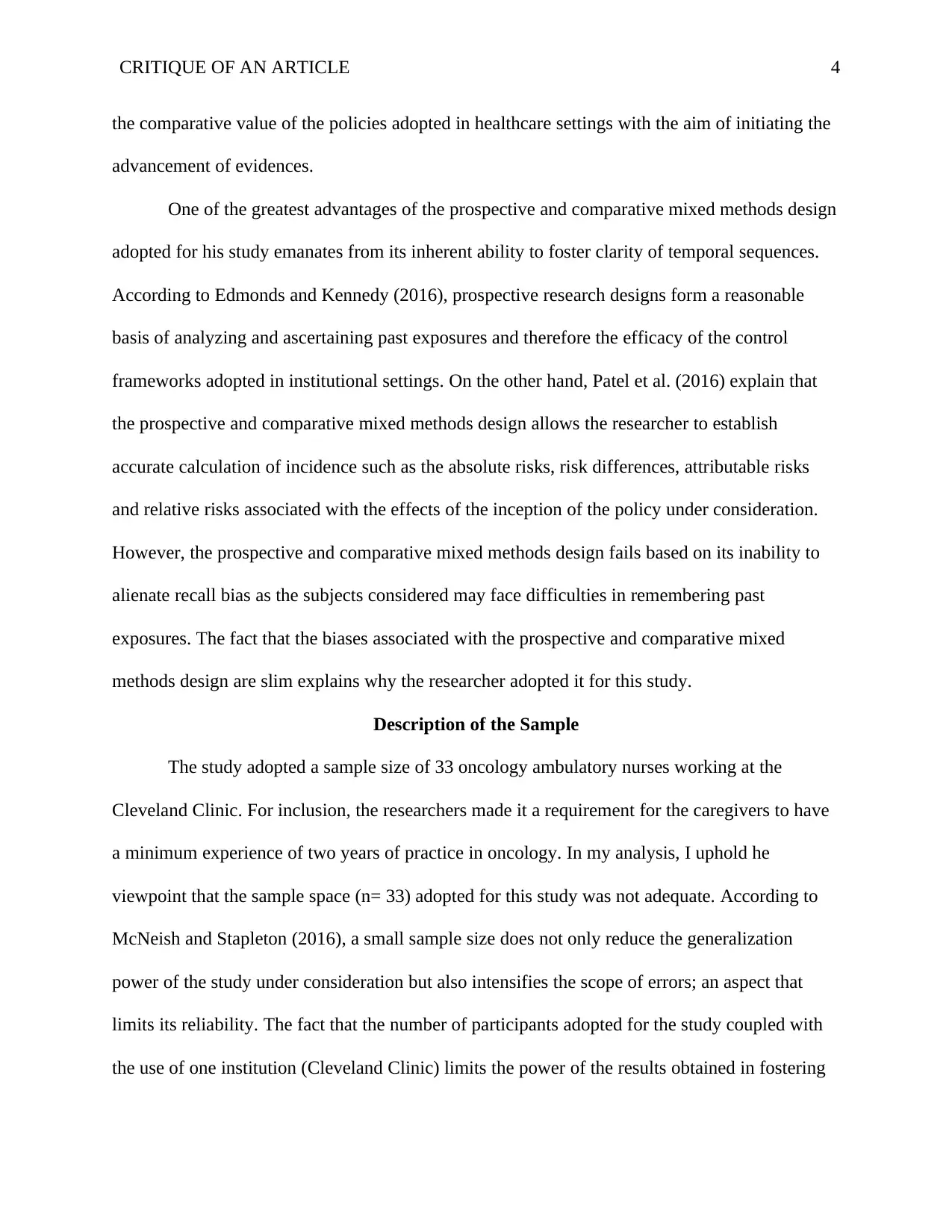
CRITIQUE OF AN ARTICLE 4
the comparative value of the policies adopted in healthcare settings with the aim of initiating the
advancement of evidences.
One of the greatest advantages of the prospective and comparative mixed methods design
adopted for his study emanates from its inherent ability to foster clarity of temporal sequences.
According to Edmonds and Kennedy (2016), prospective research designs form a reasonable
basis of analyzing and ascertaining past exposures and therefore the efficacy of the control
frameworks adopted in institutional settings. On the other hand, Patel et al. (2016) explain that
the prospective and comparative mixed methods design allows the researcher to establish
accurate calculation of incidence such as the absolute risks, risk differences, attributable risks
and relative risks associated with the effects of the inception of the policy under consideration.
However, the prospective and comparative mixed methods design fails based on its inability to
alienate recall bias as the subjects considered may face difficulties in remembering past
exposures. The fact that the biases associated with the prospective and comparative mixed
methods design are slim explains why the researcher adopted it for this study.
Description of the Sample
The study adopted a sample size of 33 oncology ambulatory nurses working at the
Cleveland Clinic. For inclusion, the researchers made it a requirement for the caregivers to have
a minimum experience of two years of practice in oncology. In my analysis, I uphold he
viewpoint that the sample space (n= 33) adopted for this study was not adequate. According to
McNeish and Stapleton (2016), a small sample size does not only reduce the generalization
power of the study under consideration but also intensifies the scope of errors; an aspect that
limits its reliability. The fact that the number of participants adopted for the study coupled with
the use of one institution (Cleveland Clinic) limits the power of the results obtained in fostering
the comparative value of the policies adopted in healthcare settings with the aim of initiating the
advancement of evidences.
One of the greatest advantages of the prospective and comparative mixed methods design
adopted for his study emanates from its inherent ability to foster clarity of temporal sequences.
According to Edmonds and Kennedy (2016), prospective research designs form a reasonable
basis of analyzing and ascertaining past exposures and therefore the efficacy of the control
frameworks adopted in institutional settings. On the other hand, Patel et al. (2016) explain that
the prospective and comparative mixed methods design allows the researcher to establish
accurate calculation of incidence such as the absolute risks, risk differences, attributable risks
and relative risks associated with the effects of the inception of the policy under consideration.
However, the prospective and comparative mixed methods design fails based on its inability to
alienate recall bias as the subjects considered may face difficulties in remembering past
exposures. The fact that the biases associated with the prospective and comparative mixed
methods design are slim explains why the researcher adopted it for this study.
Description of the Sample
The study adopted a sample size of 33 oncology ambulatory nurses working at the
Cleveland Clinic. For inclusion, the researchers made it a requirement for the caregivers to have
a minimum experience of two years of practice in oncology. In my analysis, I uphold he
viewpoint that the sample space (n= 33) adopted for this study was not adequate. According to
McNeish and Stapleton (2016), a small sample size does not only reduce the generalization
power of the study under consideration but also intensifies the scope of errors; an aspect that
limits its reliability. The fact that the number of participants adopted for the study coupled with
the use of one institution (Cleveland Clinic) limits the power of the results obtained in fostering
Paraphrase This Document
Need a fresh take? Get an instant paraphrase of this document with our AI Paraphraser
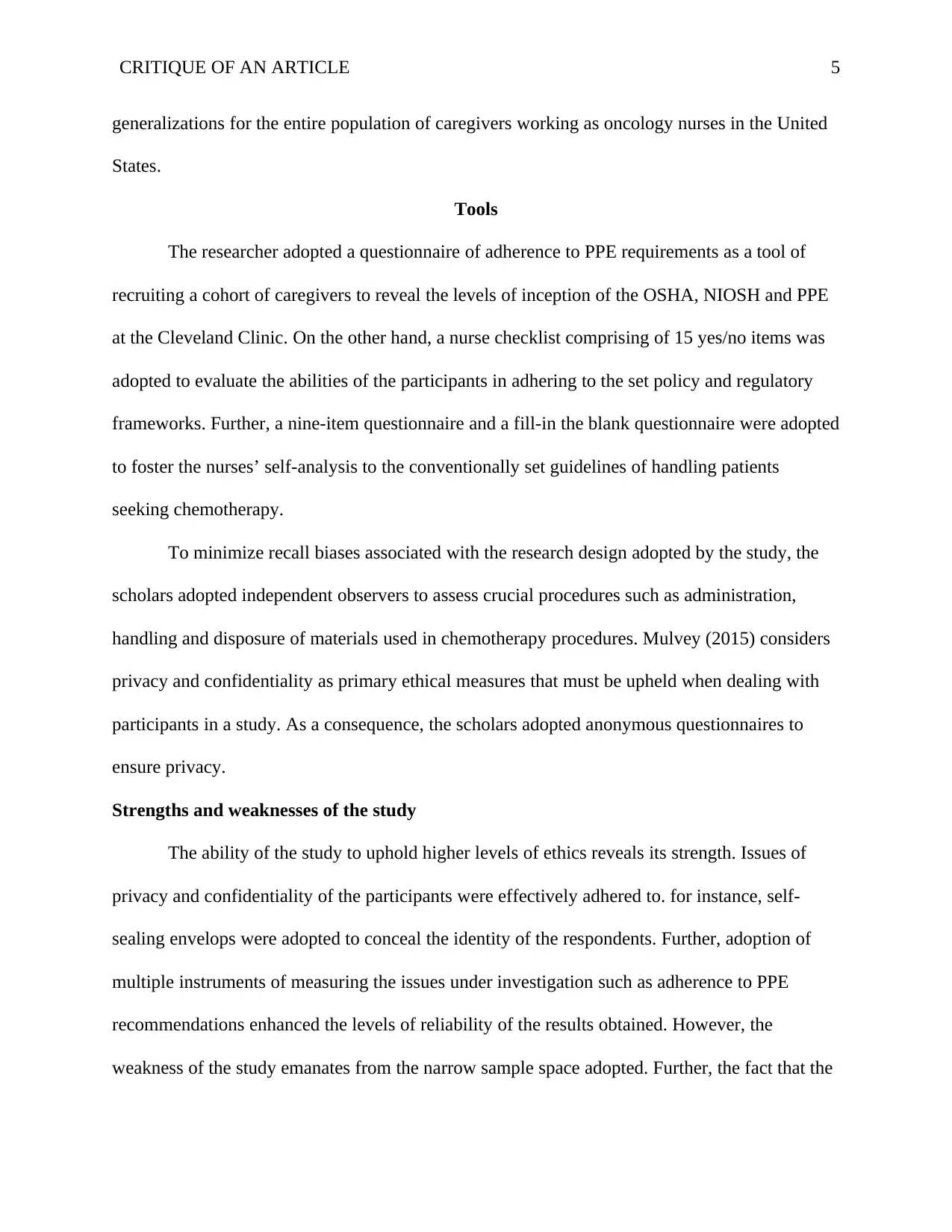
CRITIQUE OF AN ARTICLE 5
generalizations for the entire population of caregivers working as oncology nurses in the United
States.
Tools
The researcher adopted a questionnaire of adherence to PPE requirements as a tool of
recruiting a cohort of caregivers to reveal the levels of inception of the OSHA, NIOSH and PPE
at the Cleveland Clinic. On the other hand, a nurse checklist comprising of 15 yes/no items was
adopted to evaluate the abilities of the participants in adhering to the set policy and regulatory
frameworks. Further, a nine-item questionnaire and a fill-in the blank questionnaire were adopted
to foster the nurses’ self-analysis to the conventionally set guidelines of handling patients
seeking chemotherapy.
To minimize recall biases associated with the research design adopted by the study, the
scholars adopted independent observers to assess crucial procedures such as administration,
handling and disposure of materials used in chemotherapy procedures. Mulvey (2015) considers
privacy and confidentiality as primary ethical measures that must be upheld when dealing with
participants in a study. As a consequence, the scholars adopted anonymous questionnaires to
ensure privacy.
Strengths and weaknesses of the study
The ability of the study to uphold higher levels of ethics reveals its strength. Issues of
privacy and confidentiality of the participants were effectively adhered to. for instance, self-
sealing envelops were adopted to conceal the identity of the respondents. Further, adoption of
multiple instruments of measuring the issues under investigation such as adherence to PPE
recommendations enhanced the levels of reliability of the results obtained. However, the
weakness of the study emanates from the narrow sample space adopted. Further, the fact that the
generalizations for the entire population of caregivers working as oncology nurses in the United
States.
Tools
The researcher adopted a questionnaire of adherence to PPE requirements as a tool of
recruiting a cohort of caregivers to reveal the levels of inception of the OSHA, NIOSH and PPE
at the Cleveland Clinic. On the other hand, a nurse checklist comprising of 15 yes/no items was
adopted to evaluate the abilities of the participants in adhering to the set policy and regulatory
frameworks. Further, a nine-item questionnaire and a fill-in the blank questionnaire were adopted
to foster the nurses’ self-analysis to the conventionally set guidelines of handling patients
seeking chemotherapy.
To minimize recall biases associated with the research design adopted by the study, the
scholars adopted independent observers to assess crucial procedures such as administration,
handling and disposure of materials used in chemotherapy procedures. Mulvey (2015) considers
privacy and confidentiality as primary ethical measures that must be upheld when dealing with
participants in a study. As a consequence, the scholars adopted anonymous questionnaires to
ensure privacy.
Strengths and weaknesses of the study
The ability of the study to uphold higher levels of ethics reveals its strength. Issues of
privacy and confidentiality of the participants were effectively adhered to. for instance, self-
sealing envelops were adopted to conceal the identity of the respondents. Further, adoption of
multiple instruments of measuring the issues under investigation such as adherence to PPE
recommendations enhanced the levels of reliability of the results obtained. However, the
weakness of the study emanates from the narrow sample space adopted. Further, the fact that the
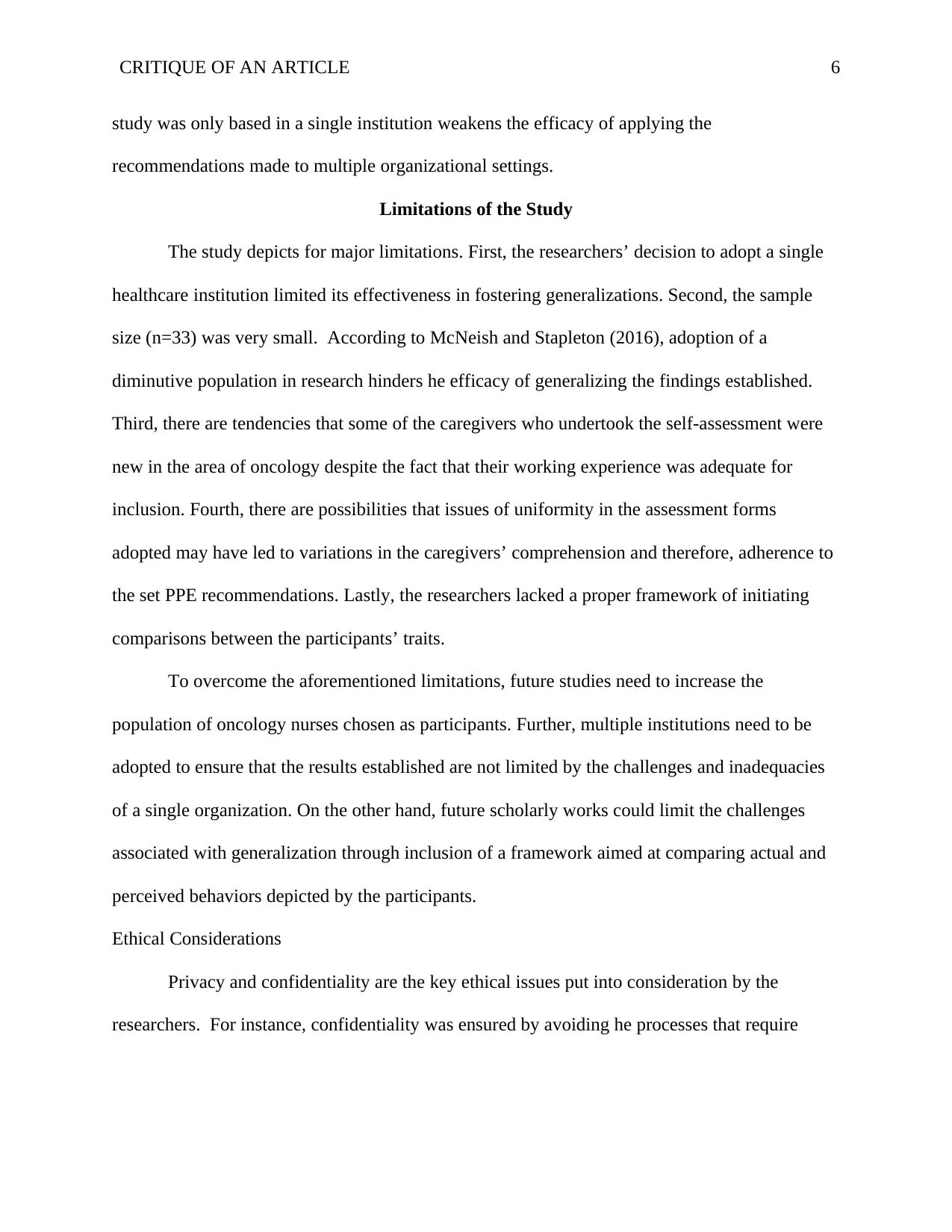
CRITIQUE OF AN ARTICLE 6
study was only based in a single institution weakens the efficacy of applying the
recommendations made to multiple organizational settings.
Limitations of the Study
The study depicts for major limitations. First, the researchers’ decision to adopt a single
healthcare institution limited its effectiveness in fostering generalizations. Second, the sample
size (n=33) was very small. According to McNeish and Stapleton (2016), adoption of a
diminutive population in research hinders he efficacy of generalizing the findings established.
Third, there are tendencies that some of the caregivers who undertook the self-assessment were
new in the area of oncology despite the fact that their working experience was adequate for
inclusion. Fourth, there are possibilities that issues of uniformity in the assessment forms
adopted may have led to variations in the caregivers’ comprehension and therefore, adherence to
the set PPE recommendations. Lastly, the researchers lacked a proper framework of initiating
comparisons between the participants’ traits.
To overcome the aforementioned limitations, future studies need to increase the
population of oncology nurses chosen as participants. Further, multiple institutions need to be
adopted to ensure that the results established are not limited by the challenges and inadequacies
of a single organization. On the other hand, future scholarly works could limit the challenges
associated with generalization through inclusion of a framework aimed at comparing actual and
perceived behaviors depicted by the participants.
Ethical Considerations
Privacy and confidentiality are the key ethical issues put into consideration by the
researchers. For instance, confidentiality was ensured by avoiding he processes that require
study was only based in a single institution weakens the efficacy of applying the
recommendations made to multiple organizational settings.
Limitations of the Study
The study depicts for major limitations. First, the researchers’ decision to adopt a single
healthcare institution limited its effectiveness in fostering generalizations. Second, the sample
size (n=33) was very small. According to McNeish and Stapleton (2016), adoption of a
diminutive population in research hinders he efficacy of generalizing the findings established.
Third, there are tendencies that some of the caregivers who undertook the self-assessment were
new in the area of oncology despite the fact that their working experience was adequate for
inclusion. Fourth, there are possibilities that issues of uniformity in the assessment forms
adopted may have led to variations in the caregivers’ comprehension and therefore, adherence to
the set PPE recommendations. Lastly, the researchers lacked a proper framework of initiating
comparisons between the participants’ traits.
To overcome the aforementioned limitations, future studies need to increase the
population of oncology nurses chosen as participants. Further, multiple institutions need to be
adopted to ensure that the results established are not limited by the challenges and inadequacies
of a single organization. On the other hand, future scholarly works could limit the challenges
associated with generalization through inclusion of a framework aimed at comparing actual and
perceived behaviors depicted by the participants.
Ethical Considerations
Privacy and confidentiality are the key ethical issues put into consideration by the
researchers. For instance, confidentiality was ensured by avoiding he processes that require
⊘ This is a preview!⊘
Do you want full access?
Subscribe today to unlock all pages.

Trusted by 1+ million students worldwide
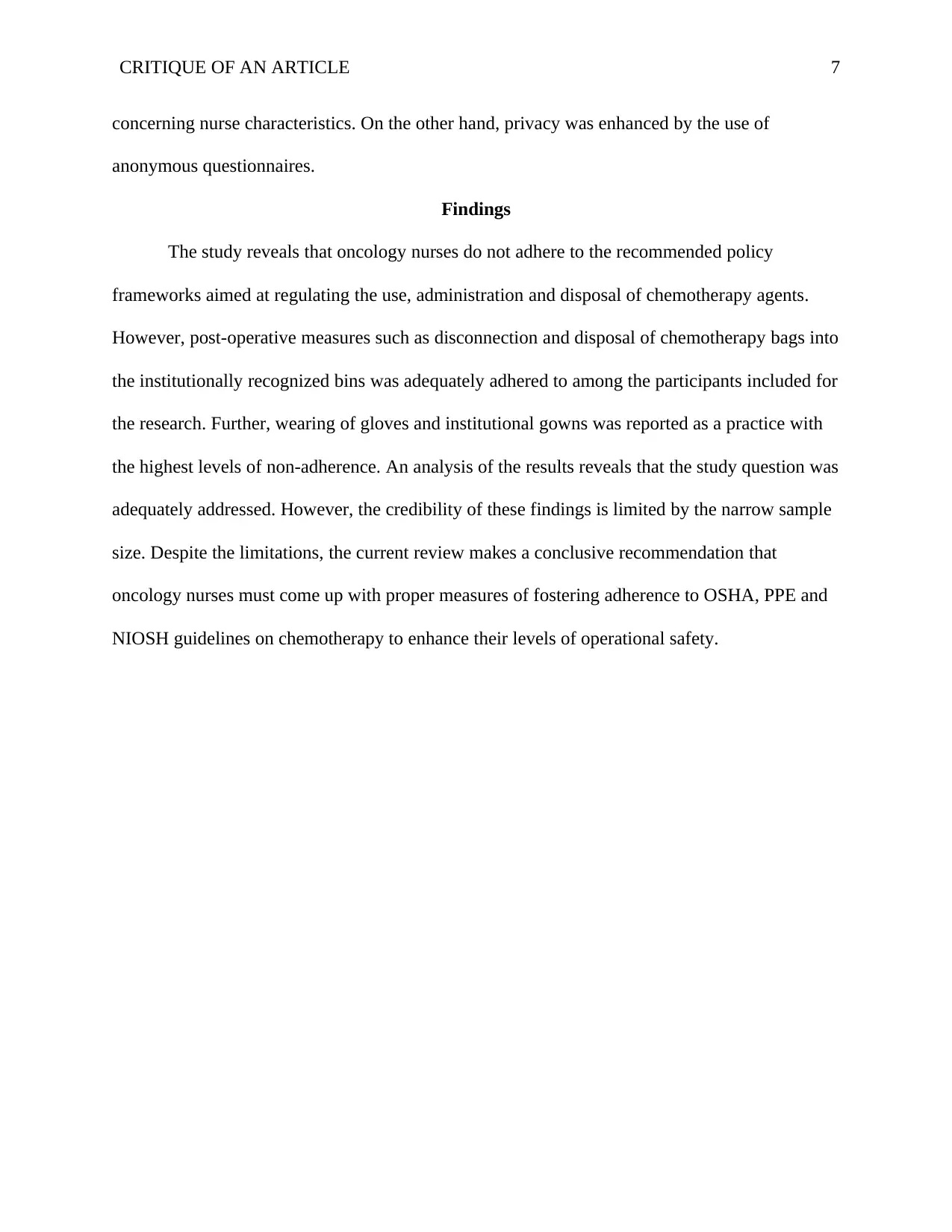
CRITIQUE OF AN ARTICLE 7
concerning nurse characteristics. On the other hand, privacy was enhanced by the use of
anonymous questionnaires.
Findings
The study reveals that oncology nurses do not adhere to the recommended policy
frameworks aimed at regulating the use, administration and disposal of chemotherapy agents.
However, post-operative measures such as disconnection and disposal of chemotherapy bags into
the institutionally recognized bins was adequately adhered to among the participants included for
the research. Further, wearing of gloves and institutional gowns was reported as a practice with
the highest levels of non-adherence. An analysis of the results reveals that the study question was
adequately addressed. However, the credibility of these findings is limited by the narrow sample
size. Despite the limitations, the current review makes a conclusive recommendation that
oncology nurses must come up with proper measures of fostering adherence to OSHA, PPE and
NIOSH guidelines on chemotherapy to enhance their levels of operational safety.
concerning nurse characteristics. On the other hand, privacy was enhanced by the use of
anonymous questionnaires.
Findings
The study reveals that oncology nurses do not adhere to the recommended policy
frameworks aimed at regulating the use, administration and disposal of chemotherapy agents.
However, post-operative measures such as disconnection and disposal of chemotherapy bags into
the institutionally recognized bins was adequately adhered to among the participants included for
the research. Further, wearing of gloves and institutional gowns was reported as a practice with
the highest levels of non-adherence. An analysis of the results reveals that the study question was
adequately addressed. However, the credibility of these findings is limited by the narrow sample
size. Despite the limitations, the current review makes a conclusive recommendation that
oncology nurses must come up with proper measures of fostering adherence to OSHA, PPE and
NIOSH guidelines on chemotherapy to enhance their levels of operational safety.
Paraphrase This Document
Need a fresh take? Get an instant paraphrase of this document with our AI Paraphraser
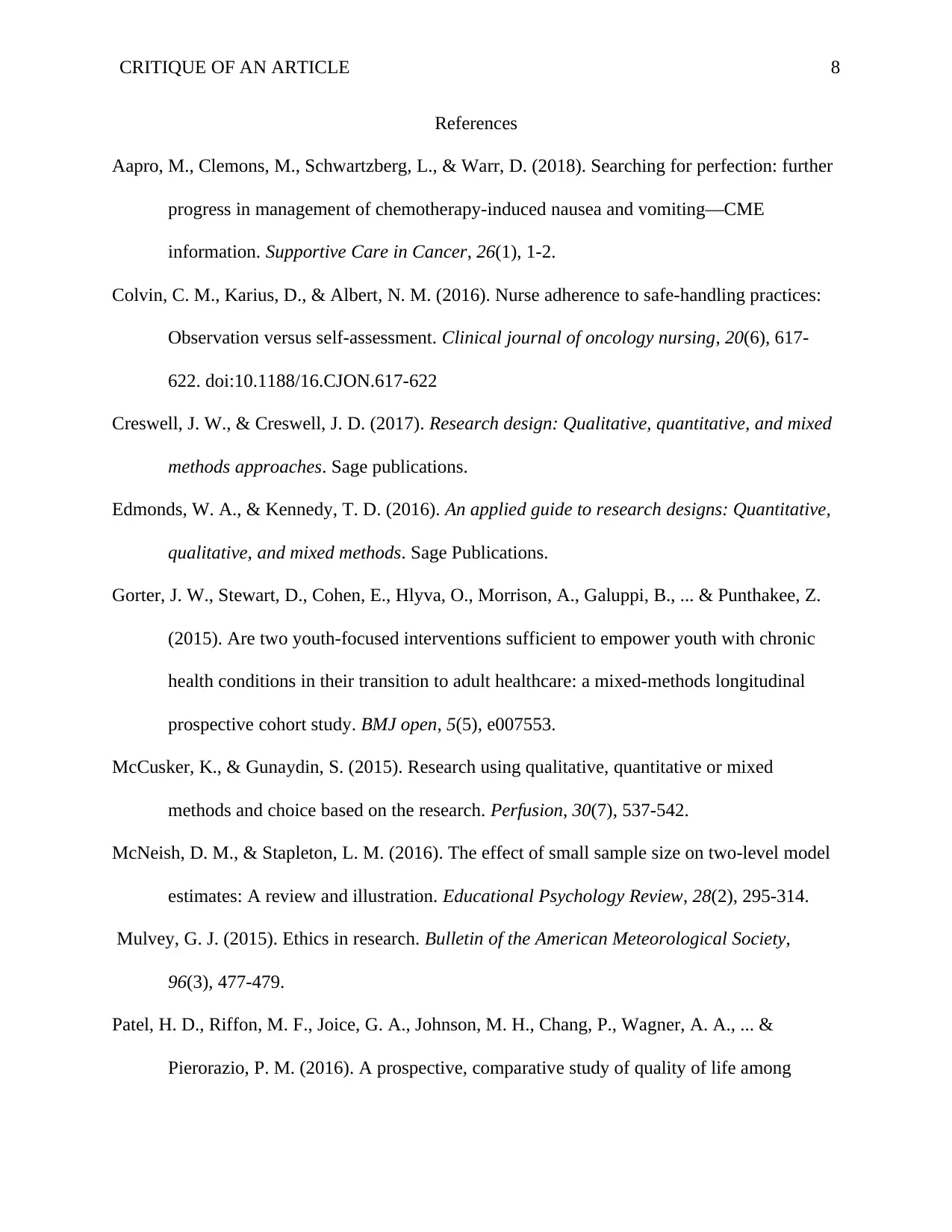
CRITIQUE OF AN ARTICLE 8
References
Aapro, M., Clemons, M., Schwartzberg, L., & Warr, D. (2018). Searching for perfection: further
progress in management of chemotherapy-induced nausea and vomiting—CME
information. Supportive Care in Cancer, 26(1), 1-2.
Colvin, C. M., Karius, D., & Albert, N. M. (2016). Nurse adherence to safe-handling practices:
Observation versus self-assessment. Clinical journal of oncology nursing, 20(6), 617-
622. doi:10.1188/16.CJON.617-622
Creswell, J. W., & Creswell, J. D. (2017). Research design: Qualitative, quantitative, and mixed
methods approaches. Sage publications.
Edmonds, W. A., & Kennedy, T. D. (2016). An applied guide to research designs: Quantitative,
qualitative, and mixed methods. Sage Publications.
Gorter, J. W., Stewart, D., Cohen, E., Hlyva, O., Morrison, A., Galuppi, B., ... & Punthakee, Z.
(2015). Are two youth-focused interventions sufficient to empower youth with chronic
health conditions in their transition to adult healthcare: a mixed-methods longitudinal
prospective cohort study. BMJ open, 5(5), e007553.
McCusker, K., & Gunaydin, S. (2015). Research using qualitative, quantitative or mixed
methods and choice based on the research. Perfusion, 30(7), 537-542.
McNeish, D. M., & Stapleton, L. M. (2016). The effect of small sample size on two-level model
estimates: A review and illustration. Educational Psychology Review, 28(2), 295-314.
Mulvey, G. J. (2015). Ethics in research. Bulletin of the American Meteorological Society,
96(3), 477-479.
Patel, H. D., Riffon, M. F., Joice, G. A., Johnson, M. H., Chang, P., Wagner, A. A., ... &
Pierorazio, P. M. (2016). A prospective, comparative study of quality of life among
References
Aapro, M., Clemons, M., Schwartzberg, L., & Warr, D. (2018). Searching for perfection: further
progress in management of chemotherapy-induced nausea and vomiting—CME
information. Supportive Care in Cancer, 26(1), 1-2.
Colvin, C. M., Karius, D., & Albert, N. M. (2016). Nurse adherence to safe-handling practices:
Observation versus self-assessment. Clinical journal of oncology nursing, 20(6), 617-
622. doi:10.1188/16.CJON.617-622
Creswell, J. W., & Creswell, J. D. (2017). Research design: Qualitative, quantitative, and mixed
methods approaches. Sage publications.
Edmonds, W. A., & Kennedy, T. D. (2016). An applied guide to research designs: Quantitative,
qualitative, and mixed methods. Sage Publications.
Gorter, J. W., Stewart, D., Cohen, E., Hlyva, O., Morrison, A., Galuppi, B., ... & Punthakee, Z.
(2015). Are two youth-focused interventions sufficient to empower youth with chronic
health conditions in their transition to adult healthcare: a mixed-methods longitudinal
prospective cohort study. BMJ open, 5(5), e007553.
McCusker, K., & Gunaydin, S. (2015). Research using qualitative, quantitative or mixed
methods and choice based on the research. Perfusion, 30(7), 537-542.
McNeish, D. M., & Stapleton, L. M. (2016). The effect of small sample size on two-level model
estimates: A review and illustration. Educational Psychology Review, 28(2), 295-314.
Mulvey, G. J. (2015). Ethics in research. Bulletin of the American Meteorological Society,
96(3), 477-479.
Patel, H. D., Riffon, M. F., Joice, G. A., Johnson, M. H., Chang, P., Wagner, A. A., ... &
Pierorazio, P. M. (2016). A prospective, comparative study of quality of life among
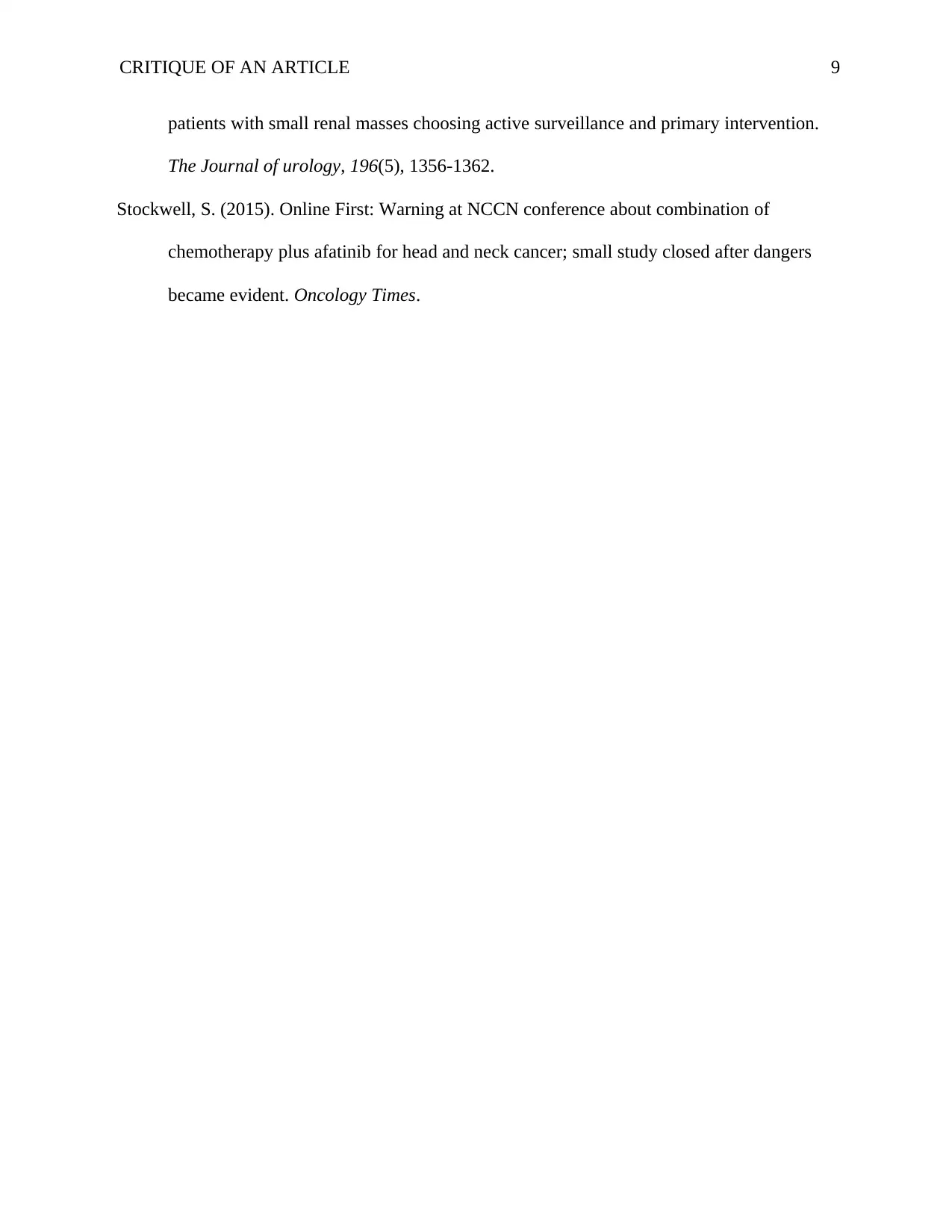
CRITIQUE OF AN ARTICLE 9
patients with small renal masses choosing active surveillance and primary intervention.
The Journal of urology, 196(5), 1356-1362.
Stockwell, S. (2015). Online First: Warning at NCCN conference about combination of
chemotherapy plus afatinib for head and neck cancer; small study closed after dangers
became evident. Oncology Times.
patients with small renal masses choosing active surveillance and primary intervention.
The Journal of urology, 196(5), 1356-1362.
Stockwell, S. (2015). Online First: Warning at NCCN conference about combination of
chemotherapy plus afatinib for head and neck cancer; small study closed after dangers
became evident. Oncology Times.
⊘ This is a preview!⊘
Do you want full access?
Subscribe today to unlock all pages.

Trusted by 1+ million students worldwide
1 out of 9
Your All-in-One AI-Powered Toolkit for Academic Success.
+13062052269
info@desklib.com
Available 24*7 on WhatsApp / Email
![[object Object]](/_next/static/media/star-bottom.7253800d.svg)
Unlock your academic potential
Copyright © 2020–2025 A2Z Services. All Rights Reserved. Developed and managed by ZUCOL.